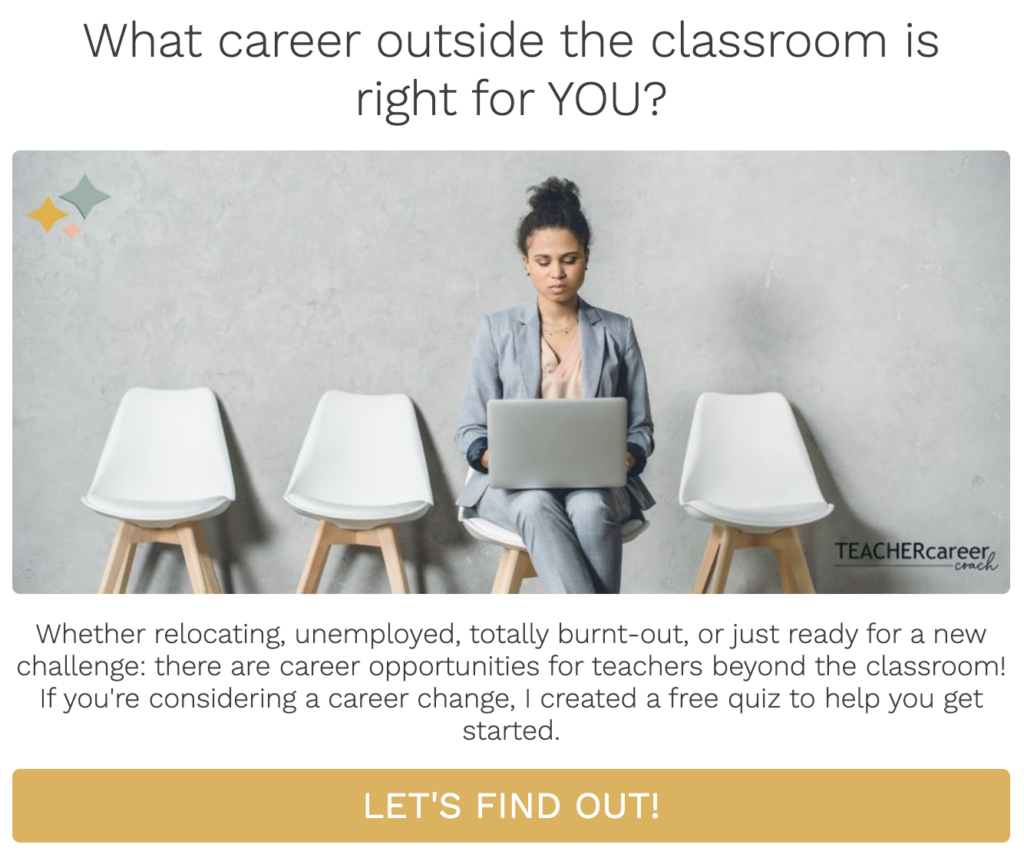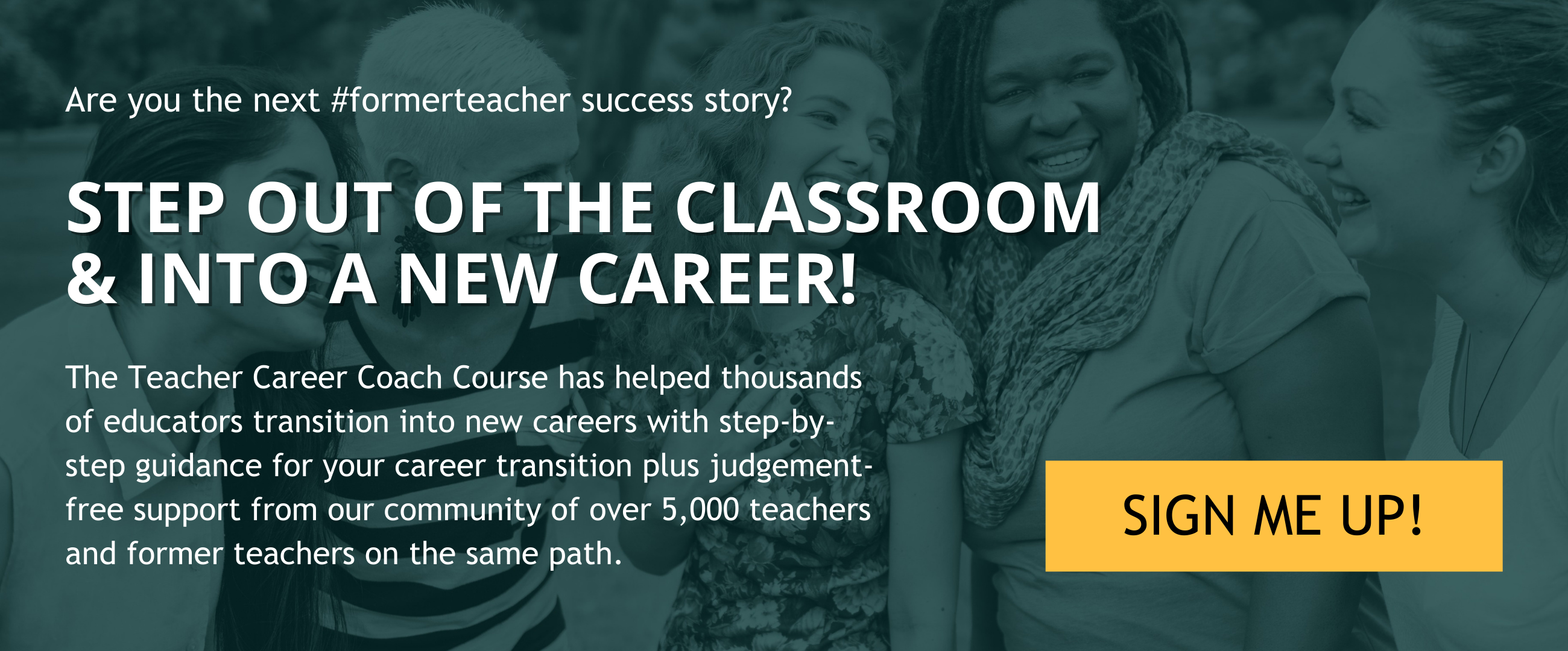This is not a drill: you probably need some LinkedIn profile tips ASAP! In this article, I’m going to share seven tips for getting started with LinkedIn and making your profile stand out!
If you need help leaving the classroom, check out the Teacher Career Coach Course. This step-by-step guide has helped thousands with a transition from teaching. Save time and get support with every step of picking a new path, rewriting your resume, and answering tricky interview questions.
LinkedIn profile tips
Did you know that up to 70% of people find a job through networking? As a teacher, I knew little to nothing about LinkedIn. I was secretly terrified to even join, thinking it would alert my district that I was looking for new positions.
Don’t let your low career confidence or fears stop you from using one of the most powerful tools out there to landing a job. The connections you’ve made are invaluable, especially on getting your foot in the door for positions that may not even be listed yet. The thought of getting in front of people may seem intimidating at first, but it may ultimately be the winning move for your teacher transition strategy.
Your LinkedIn profile is a chance to sell yourself to future employers. Make sure everything you put on your profile is accurate, authentic, and professional. This is your public, digital resume so you’ll want to carefully plan and spend the time to make it shine.
1. Stop everything. Sign up.
If you don’t have a LinkedIn profile already, set one up immediately. Ensure you use a PERSONAL email address (not your district assigned email address) while you are signing up. LinkedIn is free to use, so you can get started right away.
I recommend saving your 1-month LinkedIn Premium trial for when you are in peak application season. The timing of this will depend on your own career transition timeline as well as the peak hiring season for your desired industry. The Premium Career account offers several additional features over the basic account, including free InMails, profile views, more intel on the job and job applicants, and featured applicant status. Using your free month at the right time can give your account a boost when you really need it.
2. Selecting your profile image
Your profile image will be the first thing people will see, so your photo should be professional, friendly and engaging. If you’re currently using a picture of yourself as a classroom teacher, I would change it and try and use something that’s more of just a classic headshot with a blank background but not clearly identifying yourself as a teacher.
You want a hiring manager to look at you as a natural fit for a new role outside of the classroom. Not necessarily a teacher who is transitioning. If you can have someone look at you and just automatically imagine you in that role, it can help remove some of the stigma of someone who’s in the middle of a career pivot.
3. Developing a headline
Your headline should be smart, snappy and an opportunity for the viewer to learn something about you. Recruiters go through a lot of profiles and having something that catches the eye is a win for you. For example: Dynamic Curriculum Designer Reshaping the Future of Education. Your headline should be both accurate to who you are & shows where you want to go in your career.
4. Use the power of keywords
When creating a summary about yourself and listing your accomplishments, it is helpful to load it up with keywords. This will make it easier for recruiters to find you through searches and algorithms. As you narrow down your search, start looking for keywords in job descriptions.
For example, some keywords for a Curriculum Designers may include: analyzes school data; creates teaching strategies and standards; examines school deficits; outlines and writes new educational materials/lessons. This will let employers know what you can bring to the table.
It’s also important to mix in business keywords, such as leadership, communication, and project management.
5. Be thorough and precise
It is important to completely fill out your profile as much as possible. This includes all of your previous jobs, any volunteer work, any certifications, and of all of your skills. The algorithms scanning the networks will align people to connect with and recruiters will be able to find you through a skill search.
As a teacher, you already have skills that can be translated into more corporate-friendly terminology. For example, lesson planning can be converted into strategic planning or curriculum development; teaching is a form of training; and parent-teacher conferences can be translated into client relations or customer interactions. It’s important that hiring managers who don’t have experience in education can understand how your past experience translates into their open position.
Help translating your skills: EP 29 Writing A Transferable Teacher Skills Resume
6. Network with those in your preferred roles
When on LinkedIn, it’s a common mistake to only network with other teachers transitioning. Find those in your preferred roles with 3+ years experience in your preferred roles. After connecting, see if they will give you tips on courses you can take or blogs you can read to stand out as a competitive candidate in your role. If you make an authentic connection they may refer you to job openings in the future if they know of any. While finding a community of those also seeking employment is great for motivation, you’ll make far more progress if you branch outside.
Getting started with networking: Teacher Networking: 5 Tips for Your Career Transition
7. Search and research
LinkedIn has a lot of groups you can join to make more meaningful connections. Joining a group is helpful because you may have something in common with someone who works at company that you are trying to contact.
For instance, on LinkedIn you can search a company and search your school to see if anyone in your alumni group works there. This contact is no longer a stranger, it is now a warm lead that you can reach connect with to ask a few questions.
You can also search for specific job titles in any career that you are interested in to see if it is a good fit for you. If you find that people in a certain position have transitioned from teaching into their current role, then you’ll know that you’ll be able to do the same.
Great advice from a former teacher about networking: 60 – Networking Career Change Advice from Danielle Blake
Bonus LinkedIn profile tips: publishing articles
It you want to be known as an expert in a certain subject or create an online portfolio of your skills, you can expand your reach on LinkedIn by writing articles. If you feel that you have a lot of background knowledge on a certain industry, such as curriculum writing or consulting, and you are a talented writer, you’ll be able to create a name for yourself as an industry leader the more your articles are shared. Be sure to focus your topics on where you want to go – rather than where you’ve been or your experience in this transitional time.
If this is a strategy you want to work on, I would suggest posting an article once every two to three weeks. Recruiters and hiring managers will be able to quickly glance and your work and know that you are as knowledgeable as you seem.
However, this tip is not a make-or-break for your LinkedIn profile. You do not have to push out a lot of content or write dozens of articles for the algorithm. If you find that creating content is too distracting or takes up too much of your time, pull back and prioritize networking and making connections.
More tips for your linkedIn profile & beyond
In Episode 63 of The Teacher Career Coach Podcast, I go more in-depth on how to best use LinkedIn as a digital resume and professional networking tool. Find out about:
- Creating and expanding your network;
- Identifying your objectives;
- Creating and sharing content;
- Demonstrating professionalism;
- and how to stand out as a professional.
You can listen to The Teacher Career Coach Podcast on your favorite podcast player or listen & read the transcript for episode 63 here: Episode 63: Best Practices for LinkedIn
Next steps to a new career
One of the biggest mistakes that we see teachers make is that they try to navigate this process alone. Often, they put off “researching” until the very last minute. Which sets them up for a very stressful application season. I want to help you get some clarity in the options available to you. To know EXACTLY what you need to do (and not do) in order to get your foot in the door.
You don’t have to do this on your own.
With the help of an HR expert with over 10 years of experience and a team of former teachers, I’ve created a guide to support you in the early stages of your transition out of the classroom. Tap the button below to learn more.


